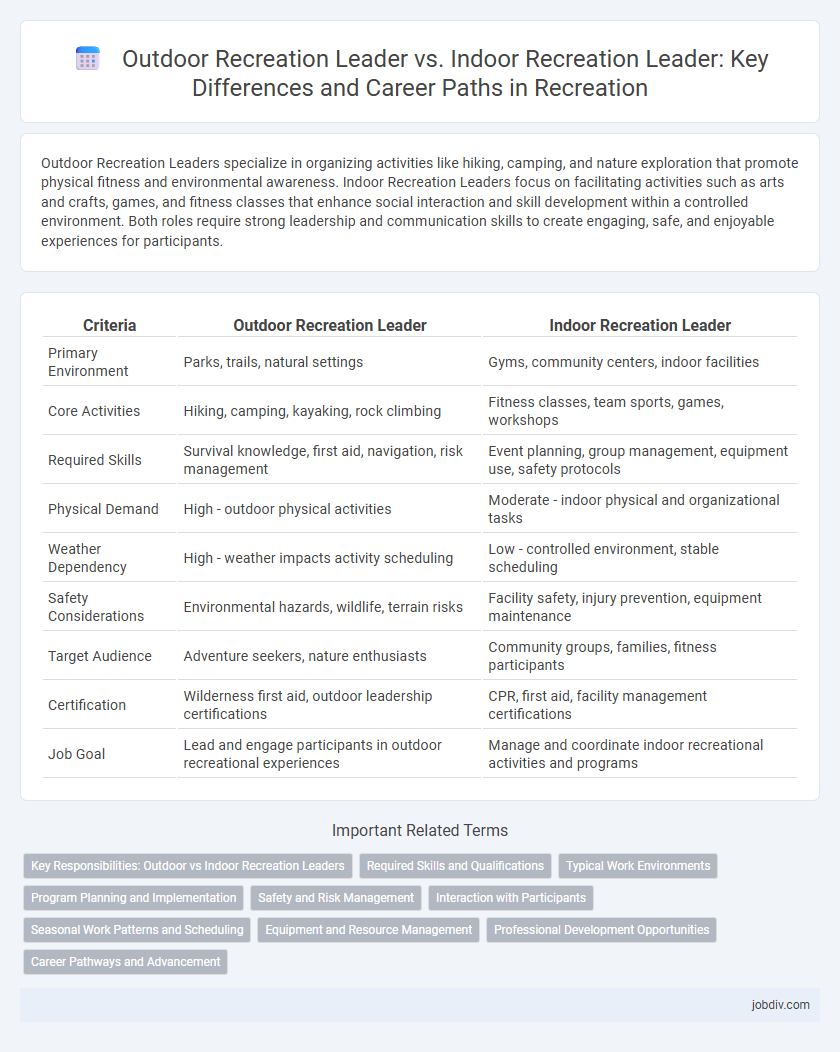Outdoor Recreation Leaders specialize in organizing activities like hiking, camping, and nature exploration that promote physical fitness and environmental awareness. Indoor Recreation Leaders focus on facilitating activities such as arts and crafts, games, and fitness classes that enhance social interaction and skill development within a controlled environment. Both roles require strong leadership and communication skills to create engaging, safe, and enjoyable experiences for participants.
Table of Comparison
| Criteria | Outdoor Recreation Leader | Indoor Recreation Leader |
|---|---|---|
| Primary Environment | Parks, trails, natural settings | Gyms, community centers, indoor facilities |
| Core Activities | Hiking, camping, kayaking, rock climbing | Fitness classes, team sports, games, workshops |
| Required Skills | Survival knowledge, first aid, navigation, risk management | Event planning, group management, equipment use, safety protocols |
| Physical Demand | High - outdoor physical activities | Moderate - indoor physical and organizational tasks |
| Weather Dependency | High - weather impacts activity scheduling | Low - controlled environment, stable scheduling |
| Safety Considerations | Environmental hazards, wildlife, terrain risks | Facility safety, injury prevention, equipment maintenance |
| Target Audience | Adventure seekers, nature enthusiasts | Community groups, families, fitness participants |
| Certification | Wilderness first aid, outdoor leadership certifications | CPR, first aid, facility management certifications |
| Job Goal | Lead and engage participants in outdoor recreational experiences | Manage and coordinate indoor recreational activities and programs |
Key Responsibilities: Outdoor vs Indoor Recreation Leaders
Outdoor Recreation Leaders coordinate activities such as hiking, camping, and team sports, emphasizing safety protocols in natural environments and environmental stewardship. Indoor Recreation Leaders organize activities like fitness classes, arts and crafts, and indoor sports, maintaining facility cleanliness and managing equipment. Both roles require strong leadership, risk management skills, and the ability to engage diverse participant groups effectively.
Required Skills and Qualifications
Outdoor Recreation Leaders require strong physical fitness, wilderness survival skills, and certifications in first aid and CPR to effectively manage activities like hiking, camping, and adventure sports. Indoor Recreation Leaders need expertise in program planning, group facilitation, and safety protocols for environments such as gyms, community centers, and recreation rooms. Both roles demand excellent communication, leadership abilities, and knowledge of risk management to ensure participant safety and engagement.
Typical Work Environments
Outdoor Recreation Leaders typically work in natural settings such as parks, hiking trails, and campsites, where they organize activities like hiking, kayaking, and team-building exercises. Indoor Recreation Leaders operate in gyms, community centers, and recreational facilities, managing programs including fitness classes, indoor sports, and arts and crafts. Both roles require strong leadership skills but differ significantly in their environments, with outdoor leaders emphasizing connection with nature and indoor leaders focusing on structured, climate-controlled spaces.
Program Planning and Implementation
Outdoor Recreation Leaders specialize in designing and implementing programs that leverage natural environments, focusing on activities like hiking, kayaking, and camping to promote physical wellness and environmental awareness. Indoor Recreation Leaders develop structured programs in facilities such as gyms and community centers, emphasizing activities like fitness classes, dance, and team sports to encourage social interaction and skill development. Both roles require adaptability and safety expertise, but Outdoor Leaders prioritize environmental risk management while Indoor Leaders focus on facility resources and participant engagement.
Safety and Risk Management
Outdoor Recreation Leaders prioritize safety by conducting thorough risk assessments of natural environments, including weather conditions, terrain hazards, and wildlife encounters. Indoor Recreation Leaders focus on managing risks related to facility maintenance, equipment safety, and participant behavior within controlled settings. Both roles implement emergency response plans and enforce safety protocols to minimize accidents and enhance participant well-being.
Interaction with Participants
Outdoor Recreation Leaders foster direct engagement with participants through activities like hiking, camping, and team sports, encouraging interpersonal communication and group cohesion in natural settings. Indoor Recreation Leaders create structured environments for social interaction via games, fitness classes, and workshops, emphasizing safety and accessibility within controlled spaces. Both roles prioritize participant well-being but differ in dynamic engagement methods driven by their respective settings.
Seasonal Work Patterns and Scheduling
Outdoor Recreation Leaders typically work seasonally, with peak activity during spring and summer months due to favorable weather conditions, resulting in flexible and often extended hours. Indoor Recreation Leaders maintain more consistent year-round schedules, benefiting from climate-controlled environments that allow steady programming regardless of weather changes. Seasonal fluctuations significantly influence workload and staffing needs, with outdoor roles demanding adaptability to variable daylight and weather patterns.
Equipment and Resource Management
Outdoor Recreation Leaders specialize in managing natural equipment such as tents, kayaks, and safety gear, ensuring proper maintenance and environmental compliance to enhance participant safety. Indoor Recreation Leaders focus on maintaining and organizing gym equipment, game rooms, and fitness machines, optimizing space and resource allocation for group activities. Both roles require expertise in inventory control and resource scheduling to facilitate efficient program delivery.
Professional Development Opportunities
Outdoor Recreation Leaders benefit from extensive professional development opportunities in wilderness survival, environmental education, and adventure programming certifications. Indoor Recreation Leaders often access specialized training in fitness instruction, facility management, and group activity coordination. Both roles require continuous skill enhancement but differ in emphasis based on environment-specific demands and certifications.
Career Pathways and Advancement
Outdoor Recreation Leaders often advance by gaining certifications in wilderness first aid, survival skills, and environmental education, enabling roles in adventure tourism, park management, or ecological conservation. Indoor Recreation Leaders typically pursue careers in facility management, therapeutic recreation, or youth programming, acquiring expertise in sports management, fitness instruction, or adaptive recreation services. Both career pathways benefit from leadership skills and project management experience, but outdoor roles emphasize physical endurance and environmental knowledge, while indoor roles prioritize customer service and program coordination.
Outdoor Recreation Leader vs Indoor Recreation Leader Infographic

 jobdiv.com
jobdiv.com